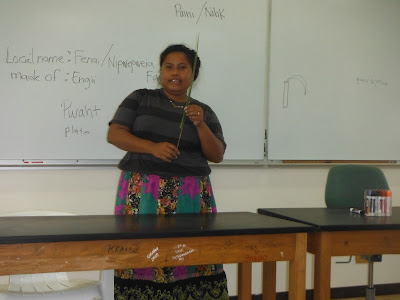Material culture
Material culture are those artifacts of life that are used as tools, shelter, transportation, and decoration. For ethnobotany they are the traditional dry goods produced from the forests and fields.
For example, the faun pwo used for pounding taro in the Mortlock islands. Only in this case the item is not botanic in origin but geologic. The pounder is made from coral. Others are made from wood.
Mitchell holds and admires the Chuukese love stick, the fenai or nipweipwei, which is no longer used.
Some material culture reflects the influence of foreign cultures. A plate for holding food for one does not make sense in a culture where food is shared and collectively eaten from a family sized kiam. This adapation of the foreign ware called a plate is locally called a pwaht.
Siorine spoke about the use of the nohk (midrib) of the coconut leaf to make brooms.
While Mitchell presented the Pohnpeian kiam, under cross-examination he yielded up that Yostrick made the kiam.
Another modern adaptation and interpretation: a purse made from pandanus leaves, locally called a kopwou tehn piht
Raydeen brought in a Mwokillese sitting mat called a rohp.
The rohp is associated with an annual fishing festival, endenkamw. Every summer the women make the mats to sit on and wait for their men to return from fishing for a particular fish. The women cook local food, the men eventually arrive with the fish. The man who comes home with the least fish has to "marry" an effigy of a woman decorated with candy.
Then the roles reverse and the women fish on the reef while the men cook. The losing woman marries a stick figure man.
Mary-Ann Henry with a tehnihr (fan)
Tom Gilimete explains the use of Ixora casei (ketieu) for dokia sticks because of the sound the wood makes. The tihp is used to remove hot items from an uhm.
Joyleen David brought in toanihr - a local fan made from a breadfruit leaf.
Yostrick explained that the koahr was used to attach thatch to the roof of a local hut. The needle could push through the layers of thatch. Today nails are replacing the koahr as nails make a smaller hole.
Some material culture reflects the influence of foreign cultures. A plate for holding food for one does not make sense in a culture where food is shared and collectively eaten from a family sized kiam. This adapation of the foreign ware called a plate is locally called a pwaht.
Siorine spoke about the use of the nohk (midrib) of the coconut leaf to make brooms.
While Mitchell presented the Pohnpeian kiam, under cross-examination he yielded up that Yostrick made the kiam.
Another modern adaptation and interpretation: a purse made from pandanus leaves, locally called a kopwou tehn piht
Raydeen brought in a Mwokillese sitting mat called a rohp.
Raydeen Julios with rohp
The rohp is associated with an annual fishing festival, endenkamw. Every summer the women make the mats to sit on and wait for their men to return from fishing for a particular fish. The women cook local food, the men eventually arrive with the fish. The man who comes home with the least fish has to "marry" an effigy of a woman decorated with candy.
Then the roles reverse and the women fish on the reef while the men cook. The losing woman marries a stick figure man.
Kiam
Mary-Ann Henry with a tehnihr (fan)
Tuhke en dokia (Ixora casei) and tihp (Hibiscus tiliaceus)
Tom Gilimete explains the use of Ixora casei (ketieu) for dokia sticks because of the sound the wood makes. The tihp is used to remove hot items from an uhm.
Joyleen David brought in toanihr - a local fan made from a breadfruit leaf.
Koahr


















Comments
Post a Comment